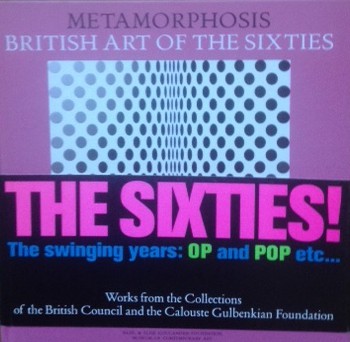Inspiring Older Readers
 posted on 13 Feb 2018
posted on 13 Feb 2018
Metamorphosis: British Art of the Sixties
Works from the collections of the British Council and the Calouste Gulbenkian Foundation
This rather beautifully produced book acted as the official catalogue of an exhibition that was held on Andros in the Greek Cyclades Islands in 2005. The plates of the artworks themselves are prefaced by essays from Kyriakos Koutsomallis, Ana Vasconcelos E Melo, Isadora Papadrakakis and Richard Riley who provides what is probably the most compelling overview of the revolution that was Sixties Op and Pop Art. Riley gives us an historic overview of where the revolution in art came from and makes the case for the Sixties being a window of opportunity for art that slammed shut as the decade turned into the 1970s. For that ten year period however the excitement was palpable:
The new decade of the sixties was finally to usher in a period of creativity and opportunity. London became one of the world’s most vibrant and important centres for contemporary art, design, fashion and music. Stimulated by this new-found confidence and sense of optimism, artists were pushing boundaries of accepted practice, and an emerging generation of artists began to take on the scale, vitality and ambition of American art.
Following the social and financial retrenchment of the Seventies and a period of neglect in the subsequent decades, Riley claims that the exhibition that this book reflects is a sign that following mature consideration the fortunes of these Sixties artists are back on the upturn.
I’m not really sure about that as a thesis because there are, it seems to me, many of the artists who made names for themselves in this period who have never really dropped out of public recognition – David Hamilton, Gillian Ayres, Peter Blake, David Hockney, Howard Hodgkin and the list goes on. For me, looking again at the examples that have been reproduced here, the distinction between the very best artists and the second division ones is very clear to see. And I’m not sure that the second rate stuff particularly deserves a ‘come back’.
Having said that, the good stuff really is very good and tremendously evocative of the time in which it was produced. The book gives us examples set out as short individual pen portraits of the featured artists set down in alphabetical order. For some of the lesser known artists this format works really well and is very democratic because they are given as much space as the bigger names get. I’m not entirely sure that’s always a good thing for the reader – I’d have liked more about and from the big hitters myself.
I picked this book up for a song and I don’t think I’ve ever seen another copy while I’ve been on my travels around the bookshops – so I was very pleased to snaffle this copy when I did. You can find second hand copies on line for about £15 and if you’re keen on art movements this would make a good introduction to the Sixties.
Terry Potter
February 2018